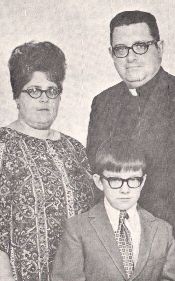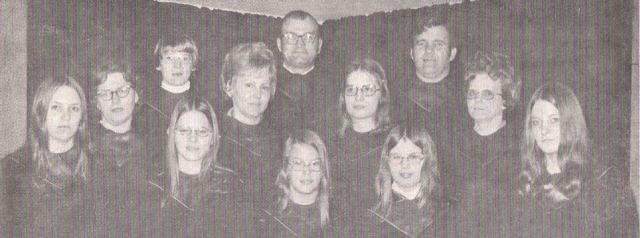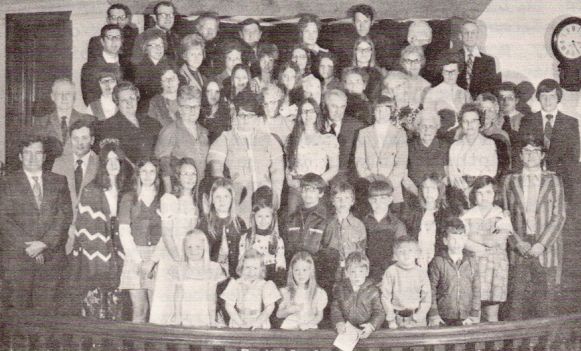![]()
Grace United Methodist Church 100 Years of God's Grace 1874 - 1974
|
THE NEW ALBIN SOCIETY OF METHODISTS
Methodism was introduced into Iowa following the 1832 Black Hawk Purchase which opened the area to white settlement. It began on September 25, 1833 when two young men were sent by the Illinois Annual Conference of the Methodist Episcopal Church to the "Galena and Dubuque Mission." This included areas of western Illinois and northeastern Iowa.
The settlement of Iowa moved rapidly. The early settlers followed the rivers. As these new settlers moved along the Mississippi River small communities formed. These new settlers, isolated, lonely, yet self-reliant, lived their lives without traditional guidance. Sabbath desecration, profanity, intemperance, immorality, and gambling prevailed.
But God called pioneer missionaries, frontier preachers to fulfill their duties to the Redeemer of man, to the redeemed among men, to their own households of faith as they moved across and along the Mississippi River. Soon came other men of God, preachers of the Gospel, God-fearing, outspoken, sacrificing preachers.
There were many of these pioneer ministers: unpretentious, clothed mainly in dark garments, sinewy, weather-beaten, unschooled, with rough and calloused hands. They were men of The Book, His Book, first and foremost. They were men of vision. They had an experience with God so real that they were constrained to testify. They couldn't stay silent. They preached Christ crucified. God had given himself for mankind. The whole world was lost excepting as individuals came to Christ. All persons needed to accept Christ as Savior and Lord and obey Him. They preached for verdicts and planted Zion in Iowa. Religion, salvation through Jesus Christ was their business and to that end they gave their apostolic labors to purify the frontiers.
During those early days many a traveling parson made infrequent stops with isolated little groups of the faithful in this area.
A small settlement was founded by a group of settlers at the foot of one of the river bluffs just across the state line in Minnesota. It was given the name "New Landing", later changed to Jefferson. Because the area did not afford adequate building space it was decided to move the settlement to a large flat sand knoll located about a mile south of the original site. In 1872 the Clinton, Dubuque and Minnesota Railway came through the area and brought prosperity to the new settlement.The name "New Albin" came about as the result of a tragedy. On July 4, 1872, a group of boys were celebrating the holiday by jumping over a large bonfire. Albin Rhomberg, age 11, his pockets full of gunpowder, stumbled and fell into the fire. He was pulled out of the fire and placed in a tub of molasses to "salve" his burns, but died the following day.
Residents of the settlement voted to name the village "Rhomberg" after J. Albin Rhomberg, the father of the boy who was burned to death, but it was the father's wish that it be called "Albin" in honor of his son. But when the matter was referred to state officials, it was discovered that there was already a town called "Albin" in the state. It was therefore decided to name the town "New Albin" in honor of this young boy who was so tragically burned to death.
There were no regular religious services held in the village for the first couple of years. Then in late 1873 and particularly early 1874, a Methodist circuit rider, Brother H.W. Houghton, began holding meetings in the community. In January, 1874, a New Albin Society of Methodists was formed and a class organized.
This group continued until May 22, 1874, when the first Quarterly Conference was held. Grace Church was organized as a part of the Allamakee County-McGregor District of the Upper Iowa Conference of the Methodist Episcopal Church.
At that first meeting, the Rev. William H. Smith was the Presiding Elder (district superintendent). The Rev. W.H. Houghton of Lansing was appointed as pastor. William H. Tuthill was elected lay leader and Dr. R.C. Ambler was elected to the office of exhorter. The first Board of Trustees included: R.C. Ambler, C.G. Bock, William N. Brown, A.B. Hayes, and W.H. Tuthill.
It was resolved that the congregation proceed with building a church edifice as soon as three-fourths of the necessary amount could be obtained on subscription. Thus the New Albin Society of Methodists became the first church in the community.
From 1874 until 1895, New Albin, Lansing and Mays Prairie were on the same circuit. In 1895, New Albin became an independent charge.
Salaries for the pastors during the early years were low. The first two pastors served without pay. The first pastor to receive a salary was paid $75 per year. At the time New Albin became an independent charge, the pastor was receiving $600 per year.
There is evidence that an active religious education program was carried on from the beginning. At the turn of the century, W.O. Bock was superintendent of the church school.
In 1902, Grace Church built a parsonage located across the street and on the corner south of the church for a cost of $2,500. This remained in use until it was sold in 1971.
Records indicate that an active set of women’s organizations flourished during these years with both a Ladies Aid and the Women's Foreign Missionary Society meeting monthly. The Epworth League, a young people's organization, and a Junior Epworth League, both were functioning.
It was during the ministry of the Rev. C.R. Disney that a need for a new church building was realized. The original building was razed and the present structure was built on the same site. Although no records remain as to the actual cost of the building, it is believed that the cost of the building was in the range of $16,000.
When the new building was dedicated on Sunday, August 27, 1916, it was one of the most modern buildings in the area. Among other things it featured its own electric plant, a hot water heating system, a completely equipped kitchen, a gymnasium or social hall, showers, a central vacuum cleaning system, and individual classrooms for instruction.
Three large stained glass windows were included in the new building. They were of an "art glass" type and are considered to be among the best examples in the area.
At the dedication ceremonies, Methodist Episcopal Bishop Homer C. Stuntz of Omaha, Nebraska, was the speaker for the day.
During the first three decades of the 20th century, Grace Church continued to flourish.In 1939, the name of Methodist Episcopal Church was dropped because of the merger of three Methodist bodies, and the denominational name was changed to The Methodist Church. In 1940, the women’s work in the church was merged to form the Women’s Society of Christian Service.
Over the years, Grace Church has been a part of several circuits. After the original circuit with Lansing and Mays Prairie was terminated, Grace Church became an independent charge. In 1933 Grace Church was yoked with French Creek Church. This field continued unti1 1955, when because of road work on Highway 76, it was decided to yoke French Creek Church with Waukon, and to yoke Saint John's Methodist Church of Dorchester with New Albin. This yoked field continued until 1971 when French Creek Church closed its doors and Dorchester was again yoked to Waukon. This left Grace Church again an independent charge. The future did not look bright.
In June of 1971, the Rev. C. Kent Wever had been called as pastor of Saint John's United Church of Christ and Mount Hope United Presbyterian Church, both rural churches located near New Albin. In conversations with District Superintendent, Edwin C. Boulton, it was arranged for Grace Church to be served by Pastor Wever. He was then appointed as pastor. Moves are now under way after three years of informal cooperation to formally yoke the three churches in a cooperative parish known as Northern Al1amakee Cooperative Parish.
In 1968, one more change in name was in store for Grace Church. This was the year when the Methodist Church and the Evangelical United Brethren denominations merged to form the United Methodist Church. Thus the name "united" was added to the name of Grace Church.
In 1974, as Grace Church marks "100 Years Of God's Grace," Methodism in New Albin continues to give witness to the Gospel of Jesus Christ. As it pioneered in this ministry in this community, even now through new forms of ministry and cooperation it seeks to fulfill the commission of Jesus Christ, "Ye shall be my witnesses". At the time of the centennial observance, Grace Church counts 115 people in the "church family."
OUR HONORED SONS
In the history of a church there are certain people who have particular places of honor. High on the honor roll of a church are the names of the men and women who have gone from the fellowship of the local church to serve in the Church Universal.
During the 100 year history of Grace United Methodist Church, four young men have given their lives to Jesus Christ to serve in His ministry. These honored sons of Grace Church include: Freeman Gillett, Edward Bellows, Wallace Hayes and Allison Hayes. Wallace and Allison Hayes were brothers. We praise God for their ministry.
THE CHRIST WINDOWS
Three art glass windows portraying the Lord Jesus in in his teachings and actions adorn the sanctuary of Grace United Methodist Church.
On the south there is a window portraying Christ in the harvest. This window is a memorial to Mr. and Mrs. G.A. Harvey and Mrs. Dorothy Gantenbein. On the west there is the window portraying Christ as the Good Shepherd. This window was presented in memory of Elizabeth A. Travis, Mary E. Bock, Cora E. Bock, and Emma F. Kumpf. On the north wall of the sanctuary is the window portraying Christ in the Garden. This window was presented by Chapter 5622 of the Epworth League and bears the emblem and motto of the young peoples movement.
PASTORAL RECORD
Grace United Methodist Church has been served over the past 100 years by a total of forty-seven "servants of the Word of God." In keeping with Methodism's principle of iterant ministry, some of these men served for only a year. Others served longer. No pastor has served more than six years in the charge before being sent to another field of God's labor. The men who have served Grace Church faithfully over the years are:
H.W. Houghton
G.W. Pratt
R.C. Ambler
A.M. Sanford
Levi N. Green
F.G. Heatly
H.J. Bowder
J.B. Wyatt
W.A. Allen
E.D. Hall
Squire Heath
R.L. Finney
W.G. Crowder
A.A. Hallett
B.C. Barnes
H.E. KesterWilliam Lease
C.C. Casper
Henry Allshouse
E.T. Gaugh
W.T. Smith
C. Roswell Disney
John Gammons
Walter Piper
E.I. Seldon
William H. Smith
Allen Gable
J.H. Barr
Elso Sarchett
Howard H. Palmer
H.H. Fletcher
Merton McKinnleyBernard Kemper
Park Anderson
Milton Northdurft
DeWitt Clinton
Emmett M. Goetschuis
Lynn J. King
F.W. Cass
Roy L. Cawley
Everett Moore
C.E. Isaacson
M.E. Beeman
Ernest Neilson
Hidetoshi Tanaka
Calvin Tiffany
C. Kent Wever
OUR PASTOR

Rev. C. Kent & Janice (Wood) Wever and their son
Phillip
The Rev. C. Kent Wever was appointed pastor of Grace United Methodist Church in August, 1971. He is following in the footsteps of his great-great-grandfather as a circuit rider of the Gospel.
Pastor Wever serves a modern-day circuit consisting of three churches from three different denominational backgrounds. In addition to his ministry in Grace Church, he serves as pastor of Saint John's United Church of Christ and Mount Hope United Presbyterian Church. All three of these churches are located in the New Albin area. This unique experiment in Christian ecumenical cooperation has been given the name Northern Allamakee Cooperative Parish.
Born in Red Oak, Iowa, on February 13, 1936, he received his public school education in Corning, Iowa. He attended college at the University of Dubuque in Dubuque, Iowa, and Tarkio College in Tarkio, Missouri. Advanced work has been done at Michigan State University and Garrett Theological Seminary.
Pastor Wever is married to the former Janice M. Wood of Greenfield, Iowa. They have one son, Phillip Andrew. The Wevers make their home in the parsonage of Saint John's Church, located six miles west of New Albin.
Before moving to New Albin, Pastor Wever served the Community United Methodist Church, Calmar, Iowa; The Federated Church, Waucoma, Iowa; and the First Presbyterian Church, Afton, Iowa. In addition he has served several interim pastorates throughout Iowa. He also was employed in the newspaper business and as a professional manager in organizational work.
WOMEN IN SERVICE FOR GOD AND CHURCH
The Christian Church through the ages owes much to the dedication and service of its women. From the earliest times, the Church has been faithfully served, urged, and inspired by Christian women.
Grace United Methodist Church stands in this fine tradition. From the earliest records it is evident that women have always played an important and moving role in the life of the congregation. At the turn of the century there were at least four women holding offices in the church.
The work of the women in the early local church was centered in two organizations. The Ladies Aid was an organization entirely for the women of Grace Church. At the same time there was a separate organization known as the Women's Foreign Missionary Society. The latter organization was Methodist in origin and purpose, but included women from other churches in the community. Both groups held monthly meetings and carried on service projects.In 1939, as the Methodist Episcopal Church became The Methodist Church, the women's work also was reorganized. The new organization was to be known as the Women's Society of Christian Service (WSCS).
At the time of the organization of the W.S.C.S. the officers were: Esther Tabbat, president; Mrs. Eric Jordan, vice-president; Margaretta Mendenhall, secretary; and Florence Irons, treasurer. Charter members were: Clara Darling, Eliza Dresselhaus, Mrs. Frank Easton, Annabell Fitchen, Florence Irons, Mrs. Bernard Kemper, Mrs. Herman Krzbietke, Margaretta Mendenhall, Mrs. J.H. Reiser, Daisy Robinson, Kate Sires, Esther Tabatt, Ruth Tufts, Ruth Wilson and Anna Wuennecke. Before the organization was very old, the membership bad grown to include 53 members. Many years of active service has been rendered by the W.S.C.S. In addition to the first officers, Mrs. Frank Wilson, Cora Thomson, Gladys Dresselhaus, Annabell Fitchen, Nettie Sires, Marjorie Bina, Esther Dee, Margaretta Mendenhall, Mattie Lenz, Gladys Danningbring and Miriam Weymiller, have all served the organization as officers for periods of at least 15 years.
In 1973, the Women's Society of Christian Service again underwent a change in name and structure. The organization name was changed to United Methodist Women in keeping with the new name of the parent denomination.
REMEMBERING
In commemoration of the Grace Church centennial, the usual chancel furniture has been removed and some pieces of original furniture have been brought out of storage and placed in use.
There are two pieces of original furniture in use from the first church building. The horse-hair-covered walnut settee occupied the place behind the pulpit in the first church. The old clock on the wall in the chancel also comes from the original church. The pulpit and old treadle-pump reed organ were both purchased for the dedication of the present building 58 years ago. The Bible on the Lord's Table dates from the turn of the century.
In the basement display are several other articles of old furnishings. Most interesting are the old benches from the first church. They feature wooden seats and backs with wrought iron ends. The backs may be reversed in the manner of old railroad coach seats.
FAITHFUL AS A SINGING PEOPLE

Grace United Methodist Church Choir
"FAITHFUL" has been the watchword for the music in Grace United Methodist Church. Music has always played an important role in worship for Methodists. Charles Wesley, brother of Methodism's founder John Wesley, dedicated his life to providing the movement with music. Hundreds of hymns that provided uplift and spirit for the young church came from his pen.
Although not large in numbers, a faithful group of dedicated people have provided the music for Grace Church throughout its 100 year history. In 100 years, the congregation has been faithfully served by only two regular organists. C.J. Travis was the organist for a period of 68 years. Following his retirement, Mrs. John (Margaretta) Mendenhall became the organist, and has served until the present time.
Through the years, there have been a number of other people who have assisted the regular organists and have served as substitutes. Organ and piano duets through much of the history of the church have provided some treasured musical memories.
A highlight of the community musical history had as its center Grace Church. The New Albin Men's Quartet not only provided inspirational music leadership for its home church, but music for most of the community's civic and social life as well. Members of the quartet were: James Sires, first tenor; C.J. Travis, lead tenor; Ed Bock, baritone and Charles Kumpf, bass. For nearly 20 years these four men used their God-given gifts for the praise of their Maker and the entertainment of their fellowmen.
Grace Church has had a regular church choir for most of its 100 years. The size of the choir, and sometimes the quality, has flourished with the success of the congregation. The Grace Church Choir has been used as the core for several larger community musical groups. These singers have presented several cantatas in the community. At present, fourteen regular choir members provide a music ministry for Grace Church under the leadership of Mr. Gary Thomas.
GRACE CHURCH FOR TOMORROW

Grace United Methodist Church Children
Into the hands of the young people we commit the future of Grace United Methodist Church. We pray that God will continue to them and their children the Grace He so richly has bestowed upon their parents and grandparents for 100 years. May they know the joy of the Resurrection Faith in serving a risen and living Savior until He comes again! Hallelujah!
CHURCH OFFICERS
Lay Leader: John C. Mendenhall
Associate Lay Leader (Exhorter): Earl R. Benson
Secretary: Mrs. Gladys Dresselhaus
Treasurer: John C. Mendenhall
Associate Treasurer: Mrs. Frank Weymiller
Membership Secretary: Mrs. Earl Benson
Secretary of Enlistment: Mrs. Marjorie Bina
BOARD OF TRUSTEES
Delbert Fink, Robert Dresselhaus, John Mendenhall, Frank Weymiller, Leslie Dresselhaus, Clinton Dee
COUNCIL ON MINISTRIES
Chairperson: Earl R. Benson
Ecumenical Aftairs: Mrs. Merle Welper
Education: Mrs. Donald Fink
Missions: Mrs. Frank Weymiller
Evangelism: Mrs. Marjorie Bina
Stewardship: John C. Mendenhall
Social Concerns: Mrs. Cleon Sires
Worship: Mrs. Joel Sires
Youth Coordinator: Harris Fink
Health and Welfare: Joel Sires
CENTENNIAL COMMITTEE
Mrs. Merle Welper, John Mendenhall, Earl Benson, Mrs. Earl Benson, Mrs. Clinton Dee, Mrs. Gary Thomas, Mrs. Douglas Sires, Mrs. Joel Sires
BISHOP
Rev. Dr. James S. Thomas, Des Moines, Iowa
DISTRICT SUPERINTENDENT
Rev. Dr. Merton B. Green, Dubuque, Iowa

Grace United Methodist Church Congregation
~source: 1974 Grace United Methodist Church Centennial Booklet
~contributed by Errin Wilker
~*~*~